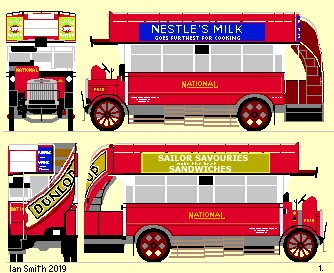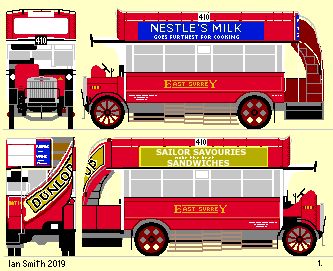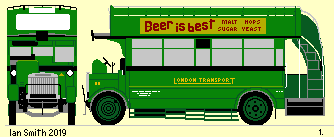
The AEC PS-typeThis page created 13th June 2019.
The S-type was seriously lacking in power, lacking the grunt needed to tackle serious hills, such as those found on the Chilterns and the North Downs. On flat roads this was not a serious problem as the solid tyres limited speeds to a legal maximum of 12 mph (rather like today's traffic speeds through Central London). So something rather better was needed for the National services run on behalf of LGOC at Watford, and also for those operated by East Surrey. The solution was basically a bigger engine: 6.8 litres, 45 bhp instead of 5.1 litres, 35 bhp. National gets the PS-type Early in 1923 LGOC built a 403 chassis with the bigger engine, with a 54-seater body and sent it to Hammersmith for work on route 11 in January. It was registered XN1800. It was then sent on in May to Watford as PS4.
Early in 1923 LGOC built a 403 chassis with the bigger engine, with a 54-seater body and sent it to Hammersmith for work on route 11 in January. It was registered XN1800. It was then sent on in May to Watford as PS4.
Meanwhile LGOC proceeded with AEC 502 chassis, bodied with open-top 43-seater bodywork. Why the bodies had such little seating is not clear. Perhaps it was the hill-climbing and the weight of passengers that mattered. Anyway, they were upseated to 54 four years later around June 1927. PS1-3 were delivered to Watford in May 1923. PS5-PS13 followed on in June and July. They wore LGOC style red and white livery, with National fleetnames. They were for use on Watford's busier routes, N1, N6 and N14. Two more, PS14 and 15, were added in January 1926. LGOC had plans to supply another nine in 1927, but National this time insisted on NS-types instead. They seem to have stayed on these routes until replaced by AEC Regent STs (highbridge on 301, lowbridge on 336 (ex-N6)) in May 1930, although published sources about the National PS buses are few and far between.
East Surrey gets the PS-typeEast Surrey also needed something more substantial than the underpowered S-type for its routes over the North Downs, notably the 409 and 410. The Tylors were capable, but undersized and getting old.
They were all built for the General in May to July 1924, and were all on loan to East Surrey, whose numbers and fleetnames they adopted. (112-132 and 134 to 142). Numbers were carried on small metal plates on the bonnet or cabside. These could be removed and replaced on body swaps at overhauls. Twelve of them were then sold to East Surrey in July, as some of the routes they used would be solely East Surrey routes, rather than routes worked on behalf of the LGOC.
Route S3 was double-decked too. It had been worked by single-decker S-types due to a low bridge south of Croydon, but a way round was found (still in use today) and a mixture of double-deckers, including old Tylors and new PSs was used. The single-deckers went back to the General. East Surrey was undertaking a garage building programme about now too. Until now many buses had to be outstationed, mostly in pub yards, at Oxted, Westerham, Westerham Hill, Sanderstead and East Grinstead. This was clearly unsatisfactory, and tough on the crews and maintenance. Petrol had to be obtained on the go. The situation was rectified with new garages at Chelsham, Godstone Green and East Grinstead during 1925 and 1926. Also in 1925 the London Transport Act meant that all buses operating within the Metropolitan Police Area had to conform with the cumbersome Bassom numbering system. These included the routes operated by East Surrey on behalf of the LGOC. S6 became 406, S9 the 409 and S10 the 410. The S24, outside the area, was unaffected, and remained S24.
AEC Regents - ST-class buses with roofs - took over most of their duties from 1931, except the 410.
LGCS and London TransportEast Surrey, along with National, were taken into London General Country Services in 1932, and the remaining PS buses of East Surrey lost their East Surrey names and numbers too.But a year later London Transport Country Area took over. Livery became green with black bands. Fleetnames became General at first, before the last eleven survivors (of all sorts) gained London Transport fleetnames. They survived on the 410 because of Oxted Railway Bridge until 1934 when the specialised Weymann-bodied front entrance STLs took over.
|
 So in spring 1924 East Surrey took delivery of thirty PS-types, based on the AEC 502 chassis with 6.8 litre engine. The bodies of this batch were slightly different, being of NS-type styling to fit the high chassis. These 48-seater bodies by Ransomes had the front of the upper deck set back slightly (reducing capacity upstairs to 24),
and a curved roof over the driver with more substantial fillets to provide wind protection, and a driver's door, presumably to save him from mud-splash on the country roads.
So in spring 1924 East Surrey took delivery of thirty PS-types, based on the AEC 502 chassis with 6.8 litre engine. The bodies of this batch were slightly different, being of NS-type styling to fit the high chassis. These 48-seater bodies by Ransomes had the front of the upper deck set back slightly (reducing capacity upstairs to 24),
and a curved roof over the driver with more substantial fillets to provide wind protection, and a driver's door, presumably to save him from mud-splash on the country roads.
 A further six PS types were supplied on loan from the LGOC in February 1926. These were 48-seaters
with standard Chiswick S-type bodies. 143-148 went onto the 409 and 410 at Godstone, releasing some of the earlier examples to replace older K-types and Tylors. (Those were kept as spares and for the weekend peaks).
A further six PS types were supplied on loan from the LGOC in February 1926. These were 48-seaters
with standard Chiswick S-type bodies. 143-148 went onto the 409 and 410 at Godstone, releasing some of the earlier examples to replace older K-types and Tylors. (Those were kept as spares and for the weekend peaks).

 Bus Stop
Bus Stop PS text.
PS text. bus histories
bus histories S buses
S buses